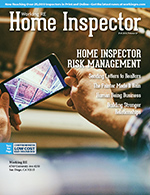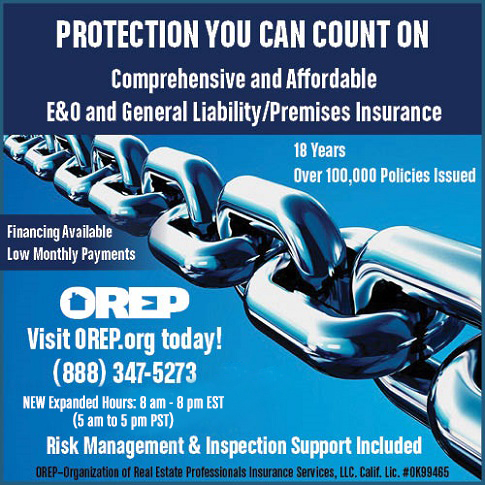 |
> E&O/GL Insurance for Home Inspectors Competitive Rates, Broad Coverage, Free Risk Management, online inspection support for tough questions, discounts on education and more... Professional Coverage, Competitive Pricing Shop OREP today! |
>> Editor’s Note: To help you stay up-to-date and connected, OREP/Working RE has established a Coronavirus (COVID-19) Discussion and Resource Page where you can share your thoughts, experiences, advice and challenges with fellow inspectors. See what Inspectors are saying here!
>> Take the Coronavirus: National Home Inspector’s Survey. Provide your industry feedback.
Home Inspector Risk Management – Part 2
by David Brauner, Senior Broker at OREP
>> To read Part 1 of this story, click here.
Most of us don’t think about “risk” too often in our day-to-day lives (thank goodness!). But as professionals, part of our focus must be on risk and our potential liability, if we want to insulate ourselves and our families from catastrophic loss. No one wants to lose gains earned from many years of hard work. Here are more tips for keeping you and your business incident free.
Foundation
This is a part of your inspection where you want to be extra careful. Foundation defects can be very expensive and you want to be careful not to just mark the foundation as “satisfactory” and move on. Foundation defects can be subtle and easy to overlook—with sellers sometimes deliberately concealing or restricting access to vital areas.
The most common signs of foundation defects include:
• Sloped or uneven floors.
• Cracks in the exterior foundation, interior or exterior walls, moldings,
or interior tiles/flooring.
• Difficult to open or close windows and doors.
• A sagging roof.
If any of the above are present, this is a warning sign that something may not be right with the foundation. A recent foundation claim involved footings and support beams that were missing—probably a builder’s error. In this particular claim, there was notable sloping in the floor that the inspector failed to report.
One of the easiest ways to check for an uneven or sloping floor is to place a tennis ball or marble on the floor and see if rolls. I know, old school. But this is a useful technique that you can perform before you inspect the basement or the property’s footings, as it can provide some warning sign that a problem might exist. Be sure to include this finding in your report.
Likewise, if you notice cracks in the foundation, be careful to include them in your report. Include a photo of the crack and recommend an additional inspection from a structural engineer. You do want to protect your client and yourself.
Inspectors can’t see through walls or floors, but it is prudent to pay special attention to the potential warning signs for foundation defects. We encourage OREP insureds to make sure they have proper training and education on foundations so they can competently assess the foundation’s integrity and report it or recommend additional inspections accordingly.
Mold and Water Damage
Mold and water damage claims are frequent and can spell serious trouble for home inspectors. For those inspectors who actually offer mold testing services, it is helpful if the reports generated by the lab provide plain-English explanations to limit confusion. The more support and information the lab can provide, the less you are involved trying to interpret or translate results. Difficult questions are best referred to the labs.
One of the upsides if you do perform mold testing is that if a client declines the mold upsell, you can have them sign a separate waiver that confirms they are declining the test and that your inspection specifically excludes mold. This provides an extra layer of protection for you because the client was offered the service and is on record as declining it—making it harder for them to bring a claim against you for mold damage down the road. This approach can be used for other services you offer as well, such as radon, sewer scoping, and more. It can be complex because oftentimes the mold problem is a result of water intrusion, which can be brought as a separate claim.
It’s important to set expectations with your clients that you are not performing a mold inspection if you are not. Many inspectors are cautious about even including the word “mold” in their reports. If you haven’t been trained to identify and test for mold, then how can you be sure the black fungus growing underneath the kitchen counter is mold? You can’t, so don’t.
If you don’t test for mold specifically, we recommend that you include a clear disclaimer in your inspection agreement, in larger typeface and bold, advising the client that you are not performing a mold inspection and that you recommend a separate mold inspection be performed by a qualified mold inspector. Ideally the client would initial this clause in your inspection agreement when executing the document, along with others such as the limitation of liability section. If you don’t inspect for mold, check with your insurance agent whether your policy includes incidental coverage. If you do test for mold, you should have training.
Of course, your job is to say something if you see something, right? Visual signs of water damage, water staining, or the growth of fungus or organic material must be clearly identified in your inspection report and backed up with supporting photographs. The homebuyer will often allege that such items were present at the time of the inspection and that you failed to report them or dismissed them verbally. Having clear language in your report and photographic evidence to disprove those allegations is a great first line of defense.
(story continues below)
(story continues)
Limitation of Liability
Unless your state law specifically prohibits it, it is recommended that you have a limitation of liability (LOL) included in your pre-inspection agreement. Such clauses limit the client’s damages to the refund of the inspection fee, regardless of the actual damages caused. In many cases, this can mean the difference between a quick resolution of a claim, with a refund of the inspection fee, versus protracted and costly litigation.
While limiting liability in this way is not possible in all states, in can be an important and effective way to manage risk. Even if a potential claimant may be able to get it thrown out of court, having it as part of your agreement can help to diffuse a dispute. Every pre-inspection agreement should also contain a severability clause, so if one part of the agreement is found to be unenforceable, the rest of the agreement must still be honored.
Don’t Break Anything
Duh, right? This one should go without saying but it’s not always so obvious ahead of time. I hope this jumps to mind if you find yourself in a situation similar to the following. One claim we reviewed recently involved an older home with cast iron plumbing. The inspector was performing a sewer line inspection and had to break the cleanout cap in order to get access to the sewer line—a plumbing practice he argued is common for old sewer lines. The inspection revealed root intrusion and a cracked sewer line. However, the seller quickly claimed that the inspector had caused the damage to the entire sewer line by hammering on the cap. The sellers then claimed that repairs were needed to the branch and main sewer lines, that a new cleanout had be installed, and of course, the home inspector should be held responsible and pay for it.
Thankfully, with the help of an ethical plumber/consultant and our team of claims professionals, the seller saw reason and accepted the home inspector’s replacement of the sewer cap. But this is a good example of why you want to be extremely careful if you are tempted to deviate from the central definition of a home inspection: a non-invasive visual inspection. A good rule of thumb for your home inspection, as well as any ancillary services you offer, such as sewer inspections, is to not perform invasive procedures in your inspection. If invasive procedures are absolutely necessary for you to adequately perform your inspection or ancillary service, you must get the seller’s agreement in writing, and any risk of property damage should be acknowledged and accepted by the seller. If you find yourself prying, yanking, hammering, or cutting anything in the course of a home inspection, please pause and reflect on this advice.
Testing Things
Be careful when you’re testing the home’s water, turning appliances on and off and if you unplug anything. Leaving the water running, an appliance turned on (like an oven or stove), or disconnecting key home systems can quickly lead to liability headaches.
One recent situation involved an inspector who tested a sump pump at a vacant house and found that it would not turn off after he turned it on. He subsequently unplugged it because he had safety concerns. But he did not tell the seller about it. Following heavy rains within days of the inspection, the seller blamed the inspector for unplugging the sump pump and causing the basement to flood. The seller insisted that the sump pump was working and pumping water at the time of the inspection and that the basement flooded specifically because the inspector unplugged it. Because the house was vacant, no one noticed the flooding until it was too late.
If you do need to disconnect or unplug anything, tell the seller and/or seller’s agent about it in writing immediately. These types of incidents can be resolved much more amicably if there is clear communication from the inspector about what was done and why. If you can’t leave the property just as you found it, you need to communicate that ASAP to the seller and/or agent. I remember one claim years ago where an inspector was accused of leaving a porch light on, which caused a fire that burned down the vacant house (it was claimed a nest caught fire). This inspector let his policy lapse and had no coverage, so I never heard how that turned out. And this brings up an important point: all home inspector policies work this way—if you let your policy lapse there is no coverage for prior inspections (search “Claims Made” at WorkingRE.com for more on this if needed).
So, renew your insurance before it expires if you plan to continue inspecting, and if you are retiring, ask your agent about tail coverage. It is gut-wrenching to realize you aren’t covered when you need it and it’s an easily avoidable mistake.
About the Author
David Brauner is Senior Broker at OREP, a leading provider of E&O Insurance for home inspectors and other real estate professionals in 50 states (OREP.org). He has provided E&O insurance to home inspectors for over 25 years. Contact him at dbrauner@orep.org or (888) 347-5273. OREP–Organization of Real Estate Professionals Insurance, LLC. Calif. Lic. #0K99465.
OREP/WRE Coronavirus Discussion and Resource Page
Coronavirus: National Home Inspector Survey
Free Risk Management Online Course Claims and Complaints: How to Stay Out of Trouble
Available Now
Presenter: David Brauner, Senior Insurance Broker OREP
David Brauner, Senior Broker at OREP, shares insights and advice gained over 25+ years of providing E&O insurance for inspectors, showing you how to protect yourself and your business. Watch Now!
Note: The Fall 2020 issue of Working RE Inspector is mailing now to over 25,000 home inspectors nationwide. OREP Insureds enjoy guaranteed delivery of each print magazine and many more benefits.


